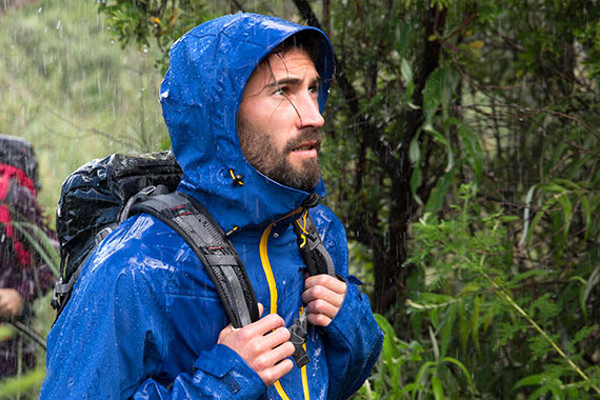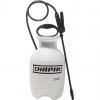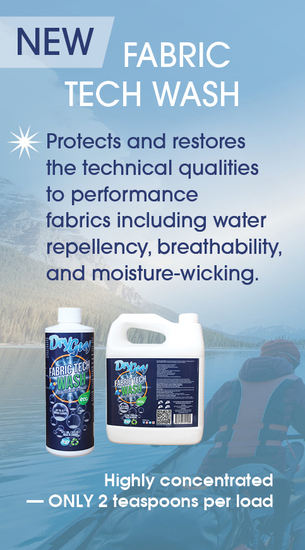Everybody loves hiking in moderate temperatures beneath a bright, sunny sky, right? But bad weather happens -- and even if you were to stay home every time you saw a cloud in the sky, you'd eventually get rained upon while out hiking. Here's how not to suffer when it happens -- and hey, you might even learn to enjoy the new sights, sounds and smells. As anyone from the Pacific Northwest can tell you, there's something magical about hiking in the rain.
How to Dress
Dressing to hike in the rain is a lot like dressing for a winter hike. Here's an example of layers that keep you warm even if you do happen to get wet, starting closest to your skin and working out:
Non-cotton underwear
Non-cotton long underwear
Non-cotton insulating layer
Waterproof shell layer
Just like on a winter hike, having multiple layers on allows you to quickly and easily adjust your clothing to suit your activity level. (Your body won't stop sweating just because it's raining -- and when you're working so hard to avoid getting wet from the outside, the last thing you want to do is wet yourself down with sweat from the inside.)
If you're hiking in warm weather, every layer can be lightweight; you might even leave the insulating layer in your pack altogether. Avoid cotton like the plague, though, even when it comes to underwear. Opt for polyester, nylon, wool or silk instead. Cotton holds any moisture -- whether from rain or sweat -- against your skin and robs your body of heat; the other materials will still insulate you to varying degrees, even when wet.
What About Gear?
Unless your pack trumpets its complete waterproofness, has sealed/taped seams and waterproof zippers, and has a really great closure, heavy rain (or even a constant drizzle) means you're going to need a rain cover. The cover is just as important for the bottom of the backpack down on wet ground is a great way to get the contents wet, as moisture soaks through the fabric from the bottom up.
Some packs come with rain covers built in (check around the bottom -- it'd be tucked into a little pocket). With other packs, you purchase the raincover separately; and every so often there's a pack with no specially-made raincover available for it at all.
No raincover? No problem. You can improvise one with a plastic garbage bag. Either pull the garbage bag over your pack from the top (tear holes for the straps if you have to) or waterproof your pack from the inside with a garbage bag as a liner. Dry bags are even better at keeping everything dry if you have them.
Camping in the Rain
If you're overnighting in the rain, a few tricks can help you stay as dry as possible:
Set your tent up fast! If you're lucky enough to have a couple of friends along, they can hold your rainfly out over your tent while you set the tent body up. Or if you're carrying a separate tarp for a cook shelter, set your tent up beneath that (then carry either tarp or tent to its usual, separate location).
Be warned: Some tent manufacturers trumpet the ability to set up their tents rainfly first. In actual practice, this is usually a colossal pain in the butt that requires you to carry the footprint (extra weight) and doesn't necessarily keep the tent body that much drier by the time you're done. Practice before you go to find out whether it's worth going fly-first with your particular tent.
Keeping the inside of the tent dry requires some attention. Pitch the tent/rainfly as taut as possible so it'll shed water properly. If you're in a single-wall tent, do not touch the wall of the tent -- water will seep through. If you're in a double-wall tent, don't touch the inner wall of the tent to the outer wall -- the rain will seep through.
Leave wet gear and outer layers in the vestibule (hopefully you have one) when you enter the tent; you might choose to keep damp inner layers inside the tent where your body heat can help dry them out, but make sure you adjust the tent's vents to allow some airflow -- yes, even in the rain. Without decent airflow, condensation will form inside the tent and you'll just end up wet anyway.
Having a sleeping bag with synthetic insulation comes in handy in wet conditions. Even if the bag gets dampened by rain or condensation, it'll still keep you warm. A down bag, on the other hand, loses quite a bit of its loft -- and thus insulation -- when wet. If you have a down bag, consider carrying it, and a dry change of clothes, in a dry bag where you know they'll stay dry no matter what. If a dry bag's not in your budget, use a garbage bag or even heavy-duty zip-close bags (for the small stuff).
Never cook inside your tent! The fumes can kill you, and it's easier than you think to accidentally burn your only shelter down. Your options include cooking in the vestibule area (very carefully, since fire is still a risk; avoid this if you can in bear country -- you should never sleep where you cook and eat), cooking in some other sheltered area (underneath an evergreen tree sometimes works) or cooking under the extra tarp you hopefully brought.
More Tips for Hiking in the Rain
Hiking in the rain really isn't that bad. I'm not such a fan of hiking in soggy tundra, but I love hiking in the forest during a light to moderate rain. I enjoy listening to and watching the rainfall, and the feeling that the forest is peacefully drowsing around me. Here are a few more tips to help you enjoy your rainy hikes, too:
If you wear glasses, carry a non-cotton ball cap to keep the rain off your face. Even though most hiking jackets have a vestigial bill on the hood to protect your face, your glasses will still get spattered without that cap. (Put the cap on, then pull the hood on over it.)
Does your outer layer have pit zips? If so, be careful when reaching overhead with the pit zips open -- water might funnel right down your sleeve and through the open zippers.
If you're walking around in the rain without waterproof boots, your feet are going to get wet through -- ditto for your pants legs if you're walking through wet vegetation. This isn't necessarily too bad as long as you have non-cotton layers on, but if you don't like getting wet (or are backpacking and will have to put those layers back on in the morning), wear waterproof pants. Gaiters will complete the waterproofing protection for your lower body.
Carry an extra pair of socks (in addition to your sleep socks, if you're backpacking) to change into once things dry out.
Got a favorite rainy-day tip to share with your fellow hikers? Drop me a line and I'll add it to the list!



















Comments